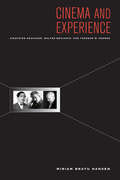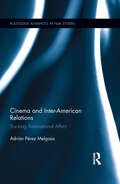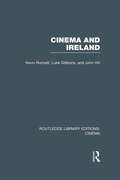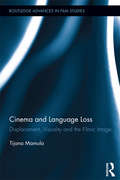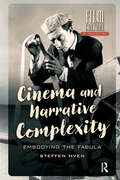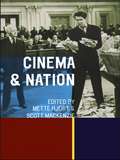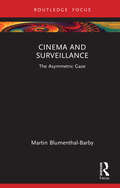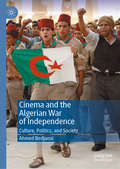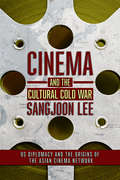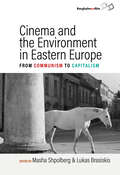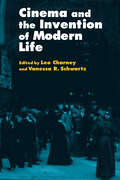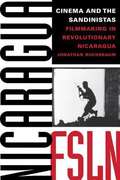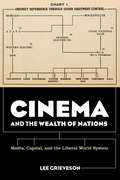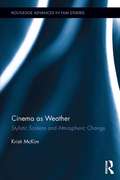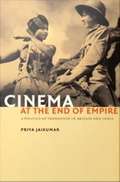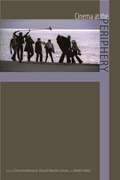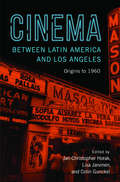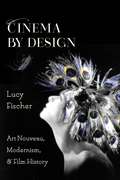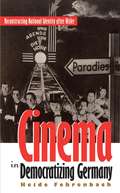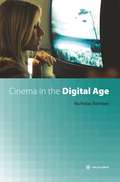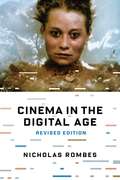- Table View
- List View
Cinema and Experience: Siegfried Kracauer, Walter Benjamin, and Theodor W. Adorno (Weimar and Now: German Cultural Criticism)
by Miriam HansenSiegfried Kracauer, Walter Benjamin, and Theodor W. Adorno—affiliated through friendship, professional ties, and argument—developed an astute philosophical critique of modernity in which technological media played a key role. This book explores in depth their reflections on cinema and photography from the Weimar period up to the 1960s. Miriam Bratu Hansen brings to life an impressive archive of known and, in the case of Kracauer, less known materials and reveals surprising perspectives on canonic texts, including Benjamin’s artwork essay. Her lucid analysis extrapolates from these writings the contours of a theory of cinema and experience that speaks to questions being posed anew as moving image culture evolves in response to digital technology.
Cinema and Inter-American Relations: Tracking Transnational Affect (Routledge Advances in Film Studies)
by Adrián Pérez MelgosaCinema and Inter-American Relations studies the key role that commercial narrative films have played in the articulation of the political and cultural relationship between the United States and Latin America since the onset of the Good Neighbor policy (1933). Pérez Melgosa analyzes the evolution of inter-American narratives in films from across the continent, highlights the social effects of the technologies used to produce these works, and explores the connections of cinema to successive shifts in hemispheric policy. As a result, Cinema and Inter-American Relations reveals the existence of a continued cinematic conversation between Anglo and Latin America about a cluster of shared allegories representing the continent and its cultures. Pérez Melgosa contends that cinema has become a virtual contact zone of the Americas, mediating in a variety of hemispheric political debates about the articulation of Anglo, Latin American, and Latino identities. Cinema and Inter-American Relations brings sustained attention to ongoing calls for a transnational focus on the disciplines of film studies, American studies, and Latin American studies and engages with current theories of the transmission of affect to delineate a new cartography of how to understand the Americas in relation to cinema.
Cinema and Ireland: Film, Culture And Politics (Routledge Library Editions: Cinema)
by John Hill Luke Gibbons Kevin RockettThis was the first comprehensive study of film production in Ireland from the silent period to the present day, and of representations of Ireland and ‘Irishness’ in native, British, and American films. It remains an authority on the topic. The book focuses on Irish history and politics to examine the context and significance of such films as Irish Destiny, The Quiet Man, Ryan’s Daughter, Man of Aran, Cal, The Courier, and The Dead.
Cinema and Language Loss: Displacement, Visuality and the Filmic Image (Routledge Advances in Film Studies)
by Tijana MamulaCinema and Language Loss provides the first sustained exploration of the relationship between linguistic displacement and visuality in the filmic realm, examining in depth both its formal expressions and theoretical implications. Combining insights from psychoanalysis, philosophy and film theory, the author argues that the move from one linguistic environment to another profoundly destabilizes the subject’s relation to both language and reality, resulting in the search for a substitute for language in vision itself – a reversal, as it were, of speaking into seeing. The dynamics of this shift are particularly evident in the works of many displaced filmmakers, which often manifest a conflicted interaction between language and vision, and through this question the signifying potential, and the perceptual ambiguities, of cinema itself. In tracing the encounter between cinema and language loss across a wide range of films – from Billy Wilder’s Sunset Boulevard to Chantal Akerman’s News from Home to Michael Haneke’s Caché – Mamula reevaluates the role of displacement in postwar Western film and makes an original contribution to film theory and philosophy based on a reconsideration of the place of language in our experience and understanding of cinema.
Cinema and Narrative Complexity: Embodying the Fabula (Film Culture in Transition)
by Steffen HvenSince the mid-1990s, a number of films from international filmmakers have experimented with increasingly complicated narrative strategies-including such hits as Run, Lola, Run, 21 Grams, and Memento. This book sets those films and others in context with earlier works that tried new narrative approaches, including Stage Fright and Hiroshima, Mon Amour, to show how they reveal the limitations of most of our usual tools for analysing film. In light of that, Steffen Hven argues for the deployment of an 'embodied' reconfiguration of the cinematic experience, one that allows us to rethink such core constituents of narrative understanding as cognition, emotion, and affect.|This book considers films that have experimented with new, increasingly complicated narrative approaches, including Stage Fright and Hiroshima, Mon Amour, to show how they reveal the limitations of most of our usual tools for analysing film.
Cinema and Nation
by Mette Hjort Scott MacKenzieIdeas of national identity, nationalism and transnationalism are now a central feature of contemporary film studies, as well as primary concerns for film-makers themselves. Embracing a range of national cinemas including Scotland, Poland, France, Turkey, Indonesia, India, Germany and America, Cinema and Nation considers the ways in which film production and reception are shaped by ideas of national belonging and examines the implications of globalisation for the concept of national cinema.In the first three Parts, contributors explore sociological approaches to nationalism, challenge the established definitions of 'national cinema', and consider the ways in which states - from the old Soviet Union to contemporary Scotland - aim to create a national culture through cinema. The final two Parts address the diverse strategies involved in the production of national cinema and consider how images of the nation are used and understood by audiences both at home and abroad.
Cinema and Social Change in Latin America: Conversations with Filmmakers
by Julianne BurtonSince the late 1960s, films from Latin America have won widening audiences in North America and Europe. Until now, no single book has offered an introduction to the diverse personalities and practices that make up this important regional film movement. In Cinema and Social Change in Latin America, Julianne Burton presents twenty interviews with key figures of Latin American cinema, covering three decades and ranging from Argentina to Mexico. Interviews with pioneers Fernando Birri, Nelson Pereira dos Santos, and Glauber Rocha, renowned feature filmmakers Tomás Gutiérrez Alea and Carlos Diegues, prize-winning documentarists Patricio Guzmán and Helena Solberg-Ladd, among others, endeavor to balance personal achievement against the backdrop of historical, political, social, and economic circumstances that have influenced each director''s career. Presented also are conversations that cast light on the related activities of acting, distribution, theory, criticism, and film-based community organizing. More than their counterparts in other regions of the world, Latin American artists and intellectuals acknowledge the degree to which culture is shaped by history and politics. Since the mid-1950s, a period of rising nationalism and regional consciousness, talented young artists and activists have sought to redefine the uses of the film medium in the Latin American context. Questioning the studio and star systems of the Hollywood industrial model, these innovators have developed new forms, content, and processes of production, distribution, and reception. The specific approaches and priorities of the New Latin American Cinema are far from monolithic. They vary from realism to expressionism, from observational documentary to elaborate fictional constructs, from "imperfect cinema" to a cinema that emulates the high production values of the developed sectors, from self-reflexive to "transparent" cinematic styles, from highly industrialized modes of production to purely artisanal ones. What does not vary is the commitment to film as a vehicle for social transformation and the expression of national and regional cultural autonomy. From early alternative cinema efforts in Argentina, Brazil, and Cuba to a contemporary perspective from within the Mexican commercial industry to the emerging cinema and video production from Central America, Cinema and Social Change in Latin America offers the most comprehensive look at Latin American film available today. Since the late 1960s, films from Latin America have won widening audiences in North America and Europe. Until now, no single book has offered an introduction to the diverse personalities and practices that make up this important regional film movement. In Cinema and Social Change in Latin America, Julianne Burton presents twenty interviews with key figures of Latin American cinema, covering three decades and ranging from Argentina to Mexico. Interviews with pioneers Fernando Birri, Nelson Pereira dos Santos, and Glauber Rocha, renowned feature filmmakers Tomás Gutiérrez Alea and Carlos Diegues, prize-winning documentarists Patricio Guzmán and Helena Solberg-Ladd, among others, endeavor to balance personal achievement against the backdrop of historical, political, social, and economic circumstances that have influenced each director''s career. Presented also are conversations that cast light on the related activities of acting, distribution, theory, criticism, and film-based community organizing. More than their counterparts in other regions of the world, Latin American artists and intellectuals acknowledge the degree to which culture is shaped by history and politics. Since the mid-1950s, a period of rising nationalism and regional consciousness, talented young artists and activists have sought to redefine the uses of the film medium in the Latin American context. Questioning the studio and star systems of the Hollywood industrial model, these innovators have developed new forms, content, and processes of production, distribution, and reception. The specific approach...
Cinema and Surveillance: The Asymmetric Gaze (Routledge Focus on Film Studies)
by Martin Blumenthal-BarbyCinema and Surveillance: The Asymmetric Gaze shows how key modern filmmakers challenge and disturb the relation between film and surveillance, medium and message. Assembling readings of films by Harun Farocki, Michael Haneke, and Fritz Lang, the book considers surveillance in such different domains as urban life, religious doctrine, and law enforcement. With surveillance present in the modern world as both a technological phenomenon and a social practice, the author shows how cinema, as a visual medium, presents highly sophisticated analyses of surveillance. He suggests that “surveillance” is less an issue to be tackled from a secure spectatorial position than an experience to be rendered, an event to be dealt with. Far from offering a general model of spectatorship, the book explores how narrative moments of surveillance are complicated by specific spectatorial responses.In its intersection of well-known figures and a highly topical issue, this book will have broad appeal, especially, but not exclusively, among students and scholars in film studies, media studies, German studies, European studies, art history, and political theory.
Cinema and the Algerian War of Independence: Culture, Politics, and Society (Palgrave Studies in Arab Cinema)
by Ahmed BedjaouiThe book examines the war of images between France and Algeria. Discussing the role of the United States during the war, it covers topics such the presence of American reporters in Algeria, John F. Kennedy’s support for Algerian independence while a senator, the broadcasting of documentaries on the Algerian war on public television, and reporting in the press. Even half a century after Algerian independence, there remains a need for both film and literature on the war from both sides of the Mediterranean. This might seem surprising, particularly to media professionals, given the quantity of output on the subject, but both French and Algerian portrayals of the war remain flawed and shackled to their respective ideologies.The generation of FLN leaders recognized early on the importance of images, and established a clandestine film structure that would bring the Algerian cause to the world stage.The book offers an insightful and timely contribution not just to the field of North African studies but also to other disciplines, such as film and media studies, anthropology, history, journalism, and political science. Providing a rich source of research topics and viable ideas for film and documentary projects, it is a must-read for students, scholars and media professionals alike.
Cinema and the Cultural Cold War: US Diplomacy and the Origins of the Asian Cinema Network (The United States in the World)
by Sangjoon LeeCinema and the Cultural Cold War explores the ways in which postwar Asian cinema was shaped by transnational collaborations and competitions between newly independent and colonial states at the height of Cold War politics. Sangjoon Lee adopts a simultaneously global and regional approach when analyzing the region's film cultures and industries. New economic conditions in the Asian region and shared postwar experiences among the early cinema entrepreneurs were influenced by Cold War politics, US cultural diplomacy, and intensified cultural flows during the 1950s and 1960s. By taking a closer look at the cultural realities of this tumultuous period, Lee comprehensively reconstructs Asian film history in light of the international relationships forged, broken, and re-established as the influence of the non-aligned movement grew across the Cold War.Lee elucidates how motion picture executives, creative personnel, policy makers, and intellectuals in East and Southeast Asia aspired to industrialize their Hollywood-inspired system in order to expand the market and raise the competitiveness of their cultural products. They did this by forming the Federation of Motion Picture Producers in Asia, co-hosting the Asian Film Festival, and co-producing films. Cinema and the Cultural Cold War demonstrates that the emergence of the first intensive postwar film producers' network in Asia was, in large part, the offspring of Cold War cultural politics and the product of American hegemony.Film festivals that took place in cities as diverse as Tokyo, Singapore, Hong Kong, and Kuala Lumpur were annual showcases of cinematic talent as well as opportunities for the Central Intelligence Agency to establish and maintain cultural, political, and institutional linkages between the United States and Asia during the Cold War. Cinema and the Cultural Cold War reanimates this almost-forgotten history of cinema and the film industry in Asia.
Cinema and the Environment in Eastern Europe: From Communism to Capitalism
by Masha Shpolberg and Lukas BrasiskisThe annexation of Eastern Europe to the Soviet sphere after World War II dramatically reshaped popular understandings of the natural environment. With an eco-critical approach, Cinema and the Environment in Eastern Europe breaks new ground in documenting how filmmakers increasingly saw cinema as a tool to critique the social and environmental damage of large-scale projects from socialist regimes and newly forming capitalist presences. New and established scholars with backgrounds across Europe, the United States, and Australia come together to reflect on how the cultural sphere has, and can still, play a role in redefining our relationship to nature.
Cinema and the Invention of Modern Life
by Leo Charney Vanessa R. SchwartzCasting aside the traditional conception of film as an outgrowth of photography, theater, and the novel, the essays in this volume reassess the relationship between the emergence of film and the broader culture of modernity. Contributors, leading scholars in film and cultural studies, link the popularity of cinema in the late nineteenth century to emerging cultural phenomena such as window shopping, mail-order catalogs, and wax museums.
Cinema and the Sandinistas: Filmmaking in Revolutionary Nicaragua
by Jonathan BuchsbaumUsing a wealth of firsthand documentation—the films themselves, interviews with numerous INCINE personnel, and INCINE archival records—Jonathan Buchsbaum follows the evolution of INCINE's project and situates it within the larger historical project of militant, revolutionary filmmaking in Latin America. His research also raises crucial questions about the viability of national cinemas in the face of accelerating globalization and technological changes which reverberate far beyond Nicaragua's experiment in revolutionary filmmaking.
Cinema and the Wealth of Nations: Media, Capital, and the Liberal World System
by Lee GrievesonCinema and the Wealth of Nations explores how media, principally in the form of cinema, was used during the interwar years by elite institutions to establish and sustain forms of liberal political economy beneficial to their interests. It examines the media produced by institutions such as states, corporations, and investment banks, as well as the emergence of a corporate media industry and system supported by state policy and integral to the establishment of a new consumer system. Lee Grieveson shows how media was used to encode liberal political and economic power during the period that saw the United States eclipse Britain as the globally hegemonic nation and the related inauguration of new forms of liberal economic globalization. But this is not a distant history. Cinema and the Wealth of Nations examines a foundational conjuncture in the establishment of media forms and a media system instrumental in, and structural to, the emergence and expansion of a world system that has been—and continues to be—brutally violent, unequal, and destructive.
Cinema as Weather: Stylistic Screens and Atmospheric Change (Routledge Advances in Film Studies)
by Kristi McKimHow do cinematic portrayals of the weather reflect and affect our experience of the world? While weatherly predictability and surprise can impact our daily experience, the history of cinema attests to the stylistic and narrative significance of snow, rain, wind, sunshine, clouds, and skies. Through analysis of films ranging from The Wizard of Oz to The Umbrellas of Cherbourg, from Citizen Kane to In the Mood for Love, Kristi McKim calls our attention to the ways that we read our atmospheres both within and beyond the movies. Building upon meteorological definitions of weather's dynamism and volatility, this book shows how film weather can reveal character interiority, accelerate plot development, inspire stylistic innovation, comprise a momentary attraction, convey the passage of time, and idealize the world at its greatest meaning-making capacity (unlike our weather, film weather always happens on time, whether for tumultuous, romantic, violent, suspenseful, or melodramatic ends). Akin to cinema's structuring of ephemera, cinematic weather suggests aesthetic control over what is fleeting, contingent, wildly environmental, and beyond human capacity to tame. This first book-length study of such a meteorological and cinematic affinity casts film weather as a means of artfully and mechanically conquering contingency through contingency, of taming weather through a medium itself ephemeral and enduring. Using film theory, history, formalist/phenomenological analysis, and eco-criticism, this book casts cinema as weather, insofar as our skies and screens become readable through our interpretation of changing phenomena.
Cinema at the City's Edge
by Yomi BraesterThis anthology includes a number of leading voices on contemporary Asian cinema studies, including Ackbar Abbas, Chris Berry, Emilie Yueh-yu Yeh, Darrell William Davis, Dudley Andrew, Yomi Braester, Susie Jie Young Kim, Akira Mizuta Lippit, James Tweedie
Cinema at the End of Empire: A Politics of Transition in Britain and India
by Priya JaikumarHow did the imperial logic underlying British and Indian film policy change with the British Empire's loss of moral authority and political cohesion? Were British and Indian films of the 1930s and 1940s responsive to and responsible for such shifts? Cinema at the End of Empire illuminates this intertwined history of British and Indian cinema in the late colonial period. Challenging the rubric of national cinemas that dominates film studies, Priya Jaikumar contends that film aesthetics and film regulations were linked expressions of radical political transformations in a declining British empire and a nascent Indian nation. As she demonstrates, efforts to entice colonial film markets shaped Britain's national film policies, and Indian responses to these initiatives altered the limits of colonial power in India. Imperially themed British films and Indian films envisioning a new civil society emerged during political negotiations that redefined the role of the state in relation to both film industries. In addition to close readings of British and Indian films of the late colonial era, Jaikumar draws on a wealth of historical and archival material, including parliamentary proceedings, state-sponsored investigations into colonial filmmaking, trade journals, and intra- and intergovernmental memos regarding cinema. Her wide-ranging interpretations of British film policies, British initiatives in colonial film markets, and genres such as the Indian mythological film and the British empire melodrama reveal how popular film styles and controversial film regulations in these politically linked territories reconfigured imperial relations. With its innovative examination of the colonial film archive, this richly illustrated book presents a new way to track historical change through cinema.
Cinema at the Periphery: Cinema At The Periphery
by Dina Iordanova David Martin-Jones Belén VidalFrom Iceland to Iran, from Singapore to Scotland, a growing intellectual and cultural wave of production is taking cinema beyond the borders of its place of origin--exploring faraway places, interacting with barely known peoples, and making new localities imaginable. In these films, previously entrenched spatial divisions no longer function as firmly fixed grid coordinates, the hierarchical position of place as "center" is subverted, and new forms of representation become possible. In Cinema at the Periphery, editors Dina Iordanova, David Martin-Jones, and Belén Vidal assemble criticism that explores issues of the periphery, including questions of transnationality, place, space, passage, and migration. Cinema at the Periphery examines the periphery in terms of locations, practices, methods, and themes. It includes geographic case studies of small national cinemas located at the global margins, like New Zealand and Scotland, but also of filmmaking that comes from peripheral cultures, like Palestinian "stateless" cinema, Australian Aboriginal films, and cinema from Quebec. Therefore, the volume is divided into two key areas: industries and markets on the one hand, and identities and histories on the other. Yet as a whole, the contributors illustrate that the concept of "periphery" is not fixed but is always changing according to patterns of industry, ideology, and taste. Cinema at the Periphery highlights the inextricable interrelationship that exists between production modes and circulation channels and the emerging narratives of histories and identities they enable. In the present era of globalization, this timely examination of the periphery will interest teachers and students of film and media studies.
Cinema between Latin America and Los Angeles: Origins to 1960
by Jacqueline Avila Alstair Tremps Viviana García Besné Desirée J. Garcia Nina HoechtlHistorically, Los Angeles and its exhibition market have been central to the international success of Latin American cinema. Not only was Los Angeles a site crucial for exhibition of these films, but it became the most important hub in the western hemisphere for the distribution of Spanish language films made for Latin American audiences. Cinema between Latin America and Los Angeles builds upon this foundational insight to both examine the considerable, ongoing role that Los Angeles played in the history of Spanish-language cinema and to explore the implications of this transnational dynamic for the study and analysis of Latin American cinema before 1960. The volume editors aim to flesh out the gaps between Hollywood and Latin America, American imperialism and Latin American nationalism in order to produce a more nuanced view of transnational cultural relations in the western hemisphere.
Cinema by Design: Art Nouveau, Modernism, and Film History (Film and Culture Series)
by Lucy FischerArt Nouveau thrived from the late 1890s through the First World War. The international design movement reveled in curvilinear forms and both playful and macabre visions and had a deep impact on cinematic art direction, costuming, gender representation, genre, and theme. Though historians have long dismissed Art Nouveau as a decadent cultural mode, its tremendous afterlife in cinema proves otherwise. In Cinema by Design, Lucy Fischer traces Art Nouveau's long history in films from various decades and global locales, appreciating the movement's enduring avant-garde aesthetics and dynamic ideology. Fischer begins with the portrayal of women and nature in the magical "trick films" of the Spanish director Segundo de Chomón; the elite dress and décor design choices in Cecil B. DeMille's The Affairs of Anatol (1921); and the mise-en-scène of fantasy in Raoul Walsh's The Thief of Bagdad (1924). Reading Salome (1923), Fischer shows how the cinema offered an engaging frame for adapting the risqué works of Oscar Wilde and Aubrey Beardsley. Moving to the modern era, Fischer focuses on a series of dramatic films, including Michelangelo Antonioni's The Passenger (1975), that make creative use of the architecture of Antoni Gaudí; and several European works of horror—The Abominable Dr. Phibes (1971), Deep Red (1975), and The Strange Color of Your Body's Tears (2013)—in which Art Nouveau architecture and narrative supply unique resonances in scenes of terror. In later chapters, she examines films like Klimt (2006) that portray the style in relation to the art world and ends by discussing the Art Nouveau revival in 1960s cinema. Fischer's analysis brings into focus the partnership between Art Nouveau's fascination with the illogical and the unconventional and filmmakers' desire to upend viewers' perception of the world. Her work explains why an art movement embedded in modernist sensibilities can flourish in contemporary film through its visions of nature, gender, sexuality, and the exotic.
Cinema in Democratizing Germany
by Heide FehrenbachHeide Fehrenbach analyzes the important role cinema played in the reconstruction of German cultural and political identity between 1945 and 1962. Concentrating on the former West Germany, she explores the complex political uses of film--and the meanings attributed to film representation and spectatorship--during a period of abrupt transition to democracy. According to Fehrenbach, the process of national redefinition made cinema and cinematic control a focus of heated ideological debate. Moving beyond a narrow political examination of Allied-German negotiations, she investigates the broader social nexus of popular moviegoing, public demonstrations, film clubs, and municipal festivals. She also draws on work in gender and film studies to probe the ways filmmakers, students, church leaders, local politicians, and the general public articulated national identity in relation to the challenges posed by military occupation, American commercial culture, and redefined gender roles. Thus highlighting the links between national identity and cultural practice, this book provides a richer picture of what German reconstruction entailed for both women and men.
Cinema in the Digital Age
by Nicholas RombesDoes the digital era spell the death of cinema as we know it? Or is it merely heralding its rebirth? Are we witnessing the emergence of something entirely new? Cinema in the Digital Age examines the fate of cinema in this new era, paying special attention to the technologies that are reshaping film and their cultural impact. Examining Festen (1998), The Blair Witch Project (1999), Timecode (2000), Russian Ark (2002), The Ring (2002), among others, this volume explores how these films are haunted by their analogue past and suggests that their signature element are their deliberate imperfections, whether those take the form of blurry or pixilated images, shakey camera work, or other elements reminding viewers of the human hand guiding the camera. Weaving together a rich variety of sources, Cinema in the Digital Age provides a deeply humanistic look at the meaning of cinematic images in the era of digital perfection.
Cinema in the Digital Age
by Nicholas RombesHave digital technologies transformed cinema into a new art, or do they simply replicate and mimic analogue, film-based cinema? Newly revised and expanded to take the latest developments into account, Cinema in the Digital Age examines the fate of cinema in the wake of the digital revolution. Nicholas Rombes considers Festen (1998), The Blair Witch Project (1999), Timecode (2000), Russian Ark (2002), and The Ring (2002), among others. Haunted by their analogue pasts, these films are interested not in digital purity but rather in imperfection and mistakes—blurry or pixilated images, shaky camera work, and other elements that remind viewers of the human behind the camera.With a new introduction and new material, this updated edition takes a fresh look at the historical and contemporary state of digital cinema. It pays special attention to the ways in which nostalgia for the look and feel of analogue disrupts the aesthetics of the digital image, as well as how recent films such as The Social Network (2010) and The Girl with the Dragon Tattoo (2011)—both shot digitally—have disguised and erased their digital foundations. The book also explores new possibilities for writing about and theorizing film, such as randomization.
Cinema in the Digital Age
by Nicholas RombesDoes the digital era spell the death of cinema as we know it? Or is it merely heralding its rebirth? Are we witnessing the emergence of something entirely new? Cinema in the Digital Age examines the fate of cinema in this new era, paying special attention to the technologies that are reshaping film and their cultural impact. Examining Festen (1998), The Blair Witch Project (1999), Timecode (2000), Russian Ark (2002), The Ring (2002), among others, this volume explores how these films are haunted by their analogue past and suggests that their signature element are their deliberate imperfections, whether those take the form of blurry or pixilated images, shakey camera work, or other elements reminding viewers of the human hand guiding the camera. Weaving together a rich variety of sources, Cinema in the Digital Age provides a deeply humanistic look at the meaning of cinematic images in the era of digital perfection.
Cinema is the Strongest Weapon: Race-Making and Resistance in Fascist Italy
by Lorenzo FabbriA deep dive into Italian cinema under Mussolini&’s regime and the filmmakers who used it as a means of antifascist resistance Looking at Italy&’s national film industry under the rule of Benito Mussolini and in the era that followed, Cinema Is the Strongest Weapon examines how cinema was harnessed as a political tool by both the reigning fascist regime and those who sought to resist it. Covering a range of canonical works alongside many of their neglected contemporaries, this book explores film&’s mutable relationship to the apparatuses of state power and racial capitalism. Exploiting realism&’s aesthetic, experiential, and affective affordances, Mussolini&’s biopolitical project employed cinema to advance an idealized vision of life under fascism and cultivate the basis for a homogenous racial identity. In this book, Lorenzo Fabbri crucially underscores realism&’s susceptibility to manipulation from diametrically opposed political perspectives, highlighting the queer, Communist, Jewish, and feminist filmmakers who subverted Mussolini&’s notion that &“cinema is the regime&’s strongest weapon&” by developing film narratives and film forms that challenged the prevailing ethno-nationalist ideology. Focusing on an understudied era of film history and Italian cultural production, Fabbri issues an important recontextualization of Italy&’s celebrated neorealist movement and the structural ties it shares with its predecessor. Drawing incisive parallels to contemporary debates around race, whiteness, authoritarianism, and politics, he presents an urgent examination into the broader impact of visual media on culture and society. Retail e-book files for this title are screen-reader friendly with images accompanied by short alt text and/or extended descriptions.
